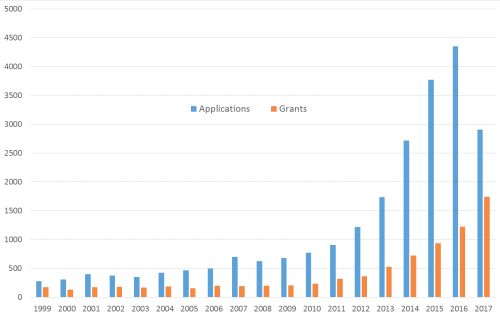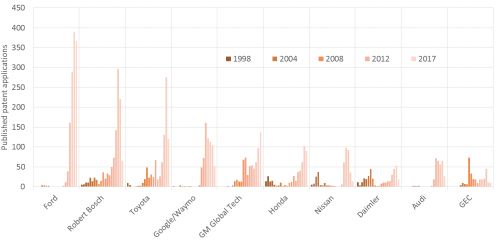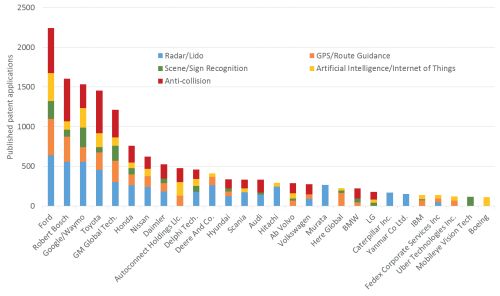Autonomous Vehicles
"Self-driving cars are the natural extension of active safety and obviously something we should do." These were the words of Elon Musk, CEO and co- founder of electric car giant, Tesla back in 2013. It's a view shared by many people active in the car industry today. Written by Andrew Flaxman
In recent years, the entire automotive sector appears to have broadened its focus to develop systems for autonomous vehicles, with the main aim of developing a safe driverless vehicle. Of course, the technology required for such vehicles has been in development for years - computer processor technology capable of performing millions of vital functions in fractions of a second, and communications technologies to allow vehicle subsystems to communicate with one another, with subsystems of other vehicles, and with other systems outside the vehicle, to name just a few. Many systems essential for driverless vehicles are already features of vehicles available today: vehicle-to-vehicle distance detection, intelligent parking assistance systems (IPAS), electronic stability control (ESC), and so on. But further developments have made it possible for computers to take greater control of vehicles, and the possibility of our roads being full of vehicles without drivers is no longer just a pipe dream.
While we're still some way off the time when cars will be functioning on public roads entirely without human control, some aspects of autonomous vehicles are by no means new. Ground vehicles capable of transporting people to destinations without an operator have been used for decades. In the Netherlands, for example, the ParkShuttle system transports passengers between five stations along a dedicated roadway.
ParkShuttle, which has been in running since 1999, operates minibuses that are guided along a set path by magnetic cables laid in the road, in a system known as "Free Ranging on Grid" (FROG).
Over the past few years, the development and testing of autonomous vehicles has received copious amounts of press coverage (both positive and negative), and it will be clear even to those unfamiliar with the technology that there has been a rapid increase in research and development in the field of vehicle automation. Our patent search and analytics team, HL Analytics, have looked at patent filing data to identify trends in this interesting and bourgeoning area.
Our first chart shows conclusively that, year-on-year, there has been strong growth in the numbers of patent applications filed in this area.

Year-on-year growth in patent applications published and patents granted. Data for patent filings in 2017 is incomplete as applications typically take 18 months to publish
As we might expect, the number of autonomous vehicle-related patent applications published around the world has seen a large rise since around 2011. The rise appears to have reduced slightly in 2016, but we are yet to understand if this represents an overall peak in filing figures in this field or just a blip in the rapid rise. Patent applications typically remain confidential for 18 months after filing, so the complete filing figures for 2017 won't be available until mid-2019. The published applications included in the above chart for 2017 represent cases which have been subject to accelerated examination/early publication.
So, where are all these patent applications being filed? Many of the news stories we've seen in recent months relate to developments made by household names in the autonomous vehicle industry - think Uber, Waymo, Tesla - all of whom are based in Silicon Valley on the west coast of the USA. While significant numbers of patent applications are being filed in other jurisdictions too, the USA seems to be the place to gain patent protection in this field, with over double the number of filings in the USA than in the next most popular jurisdiction, Germany.

Top jurisdictions for published patent applications relating to autonomous vehicles (cumulative figures, unrestricted by date)
While more applications are filed in the US than any other jurisdiction, the number of filings in other jurisdictions is not insignificant. With many major players in the vehicle manufacture market based in Germany, it is expected that patent protection in this jurisdiction will be important to many companies active in the autonomous vehicle field.
With our next charts, we consider which companies are in the driving seat when it comes to autonomous vehicles.
The following two charts show filing data for the most active applicants in this field. The first chart details the number of patent applications published and the number of patents granted to each of the top 20 filers. Car manufacturing giant, Ford, tops the table in terms of applications filed, ahead of Robert Bosch GmbH, Toyota and GM Global Technology Operations LLC. Google's spin-out, Waymo appear in fifth place in the chart.

Patent applications published and patents granted in the field of autonomous vehicles for top 20 applicants
It is also interesting to note that, despite the large number of applications filed by Ford, the number of granted patents is relatively small. In contrast, Waymo, having a lower number of patent applications published, have the largest number of granted patents of any company in the top 20. As the next chart shows, this is indicative of Ford's huge increase in patent filing activity in recent years after almost no filings in the autonomous vehicle field prior to 2013.

Yearly breakdown of autonomous vehicle patent applications filed by various applicants active over the past two decades
Of interest in the yearly breakdown chart above are the relatively strong filing figures for Honda, Nissan and Daimler in the period from around 1998 to 2005, before a long lull, with filing figures for all three companies picking up over the past few years.
It is clear that many companies are active in the field of automotive vehicles, and that the number of patent applications filed in this field has increased rapidly over the past few years. Many of the large car manufacturers now appear to be involved in developing technology for use in autonomous vehicles.
However, within the broad field of autonomous vehicles, there are a number of areas of technology in which companies are focussing their research and development.
The chart below shows the types of technologies in which each of the big filers is involved. Of course, this analysis is somewhat crude, since a patent application may relate to more than one technology. The chart does, however, give us an idea of the types of areas in which companies appear to be have focussed within the broad field of autonomous vehicles.

Pertinent technologies within the autonomous vehicle field in which the top filers are filing patent applications
Ford appear to be advancing steadily in all areas of technology relating to the development of autonomous vehicles. Google/Waymo lead the field in the number of patent applications relating to scene and sign recognition; this might be due to their ability to transfer image and feature recognition techniques from the web to vehicles. Aircraft manufacturing giant, Boeing, has filed a small number of patents in the field of artificial intelligence, showing that development in this area is not limited to ground vehicles. And we should not be fooled into believing that the relatively low filing numbers for some companies indicates that they are not planning to roll out a driverless car.
BMW, for example, have teamed up with Intel (who don't appear on our chart, but are almost certainly developing general technology that can be implemented into autonomous vehicles) and Mobileye, who are world leaders in collision-avoidance using scene recognition techniques. In fact, there are many partnerships between companies appearing in the above charts (and not appearing in the charts), enabling development of roadworthy and safe driverless vehicles through sharing knowledge, expertise and research and development resources.
So, what's next for the development of autonomous vehicles? Will taxi drivers and couriers all soon become redundant? Will we soon be able to eat breakfast and watch the morning news while driving to work? Well, one day, maybe.
Everyone wants to be the first to release a safe driverless vehicle for use on public roads, and recent press coverage seems to suggest that we're getting close to seeing fully autonomous cars on our roads in the not-too-distant future. Some companies have set targets of having fleets of driverless cars active within the next 2 to 3 years. But there are still many issues to be considered and resolved before we go fully driverless.
For example, who is responsible in the event of an accident? How will driverless cars deal with changes in road laws in different countries? Can we be entirely sure that someone won't hack into a vehicle's computer? These and many other issues are currently under discussion, and will no doubt remain as hot topics for the foreseeable future.
The content of this article is intended to provide a general guide to the subject matter. Specialist advice should be sought about your specific circumstances.


